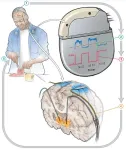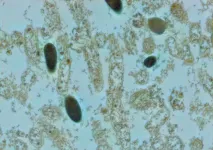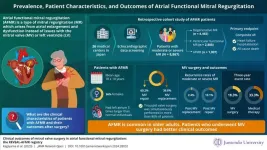(Press-News.org) Media Contact: Robin.Marks@ucsf.edu, (415) 502-6397
Subscribe to UCSF News
Taming Parkinson’s Disease with Intelligent Brain Pacemakers
UCSF studies show personalized, self-adjusting, neuromodulation has the potential to enhance movement and sleep.
Two new studies from UC San Francisco are pointing the way toward round-the-clock personalized care for people with Parkinson’s disease through an implanted device that can treat movement problems during the day and insomnia at night.
The approach, called adaptive deep brain stimulation, or aDBS, uses methods derived from AI to monitor a patient’s brain activity for changes in symptoms.
When it spots them, it intervenes with precisely calibrated pulses of electricity. The therapy complements the medications that Parkinson’s patients take to manage their symptoms, giving less stimulation when the drug is active, to ward off excess movements, and more stimulation as the drug wears off, to prevent stiffness.
It is the first time a so-called “closed loop” brain implant technology has been shown to work in Parkinson’s patients as they go about their daily lives. The device picks up brain signals to create a continuous feedback mechanism that can curtail symptoms as they arise. Users can switch out of the adaptive mode or turn the treatment off entirely with a hand-held device.
For the first study, researchers conducted a clinical trial with four people to test how well the approach worked during the day, comparing it to an earlier brain implant DBS technology known as constant or cDBS.
To ensure the treatment provided the maximum relief to each participant, the researchers asked them to identify their most bothersome symptom. The new technology reduced those symptoms by 50%. Results appear August 19 in Nature Medicine.
“This is the future of deep brain stimulation for Parkinson’s disease,” said Philip Starr, MD, PhD, the Dolores Cakebread Professor of Neurological Surgery, co-director of the UCSF Movement Disorders and Neuromodulation Clinic and one of the senior authors of the study.
Starr has been laying the groundwork for this technology for more than a decade. In 2013, he developed a way to detect and then record the abnormal brain rhythms associated with Parkinson’s. In 2021, his team identified specific patterns in those brain rhythms that correspond to motor symptoms.
“There’s been a great deal of interest in improving DBS therapy by making it adaptive and self-regulating, but it’s only been recently that the right tools and methods have been available to allow people to use this long-term in their homes,” said Starr, who was recruited by UCSF in 1998 to start its DBS program.
Earlier this year, UCSF researchers led by Simon Little, MBBS, PhD, demonstrated in Nature Communications that adaptive DBS has the potential to alleviate the insomnia that plagues many patients with Parkinson’s.
“The big shift we’ve made with adaptive DBS is that we’re able to detect, in real time, where a patient is on the symptom spectrum and match it with the exact amount of stimulation they need,” said Little, associate professor of neurology and a senior author of both studies. Both Little and Starr are members of the UCSF Weill Institute for Neurosciences.
Restoring movement
Parkinson’s disease affects about 10 million people around the world. It arises from the loss of dopamine-producing neurons in deep regions of the brain that are responsible for controlling movement. The lack of those cells can also cause non-motor symptoms, affecting mood, motivation and sleep.
Treatment usually begins with levodopa, a drug that replaces the dopamine these cells are no longer able to make. However, excess dopamine in the brain as the drug takes effect can cause uncontrolled movements, called dyskinesia. As the medication wears off, tremor and stiffness set in again.
Some patients then opt to have a standard cDBS device implanted, which provides a constant level of electrical stimulation. Constant DBS may reduce the amount of medication needed and partially reduce swings in symptoms. But the device also can over- or undercompensate, causing symptoms to veer from one extreme to the other during the day.
Closing the loop
To develop a DBS system that could adapt to a person’s changing dopamine levels, Starr and Little needed to make the DBS capable of recognizing the brain signals that accompany different symptoms.
Previous research had identified patterns of brain activity related to those symptoms in the subthalamic nucleus, or STN, the deep brain region that coordinates movement. This is the same area that cDBS stimulates, and Starr suspected that stimulation would mute the signals they needed to pick up.
So, he found alternative signals in a different region of the brain, called the motor cortex, that wouldn’t be weakened by the DBS stimulation.
The next challenge was to work out how to develop a system that could use these dynamic signals to control DBS in an environment outside the lab.
Building on findings from adaptive DBS studies that he had run at Oxford University a decade earlier, Little worked with Starr and the team to develop an approach for detecting these highly variable signals across different medication and stimulation levels.
Over the course of many months, postdoctoral scholars Carina Oehrn, MD, PhD, Stephanie Cernera, PhD, and Lauren Hammer, MD, PhD, created a data analysis pipeline that could turn all of this into personalized algorithms to record, analyze and respond to the unique brain activity associated with each patient’s symptom state.
John Ngai, PhD, who directs the Brain Research Through Advancing Innovative Neurotechnologies® initiative (The BRAIN Initiative®) at the National Institutes of Health, said the study promises a marked improvement over current Parkinson’s treatment.
“This personalized, adaptive DBS embodies The BRAIN Initiative’s core mission to revolutionize our understanding of the human brain,” he said.
A better night’s sleep
Continuous DBS is aimed at mitigating daytime movement symptoms and doesn’t usually alleviate insomnia.
But in the last decade, there has been a growing recognition of the impact that insomnia, mood disorders and memory problems have on Parkinson’s patients.
To help fill that gap, Little conducted a separate trial that included four patients with Parkinson’s and one patient with dystonia, a related movement disorder. In their paper published in Nature Communications, first author Fahim Anjum, PhD, a postdoctoral scholar in the Department of Neurology at UCSF, demonstrated that the device could recognize brain activity associated with various states of sleep. He also showed it could recognize other patterns that indicate a person is likely to wake up in the middle of the night.
Little and Starr’s research teams, including their graduate student Clay Smyth, have started testing new algorithms to help people sleep. Their first sleep aDBS study was published last year in Brain Stimulation.
Scientists are now developing similar closed-loop DBS treatments for a range of neurological disorders.
“We see that it has a profound impact on patients, with potential not just in Parkinson’s but probably for psychiatric conditions like depression and obsessive-compulsive disorder as well,” Starr said. “We’re at the beginning of a new era of neurostimulation therapies.”
Authors: Additional authors on the Nature Medicine study include Carina Oehrn, Stephanie Cernera, Lauren Hammer, Maria Shcherbakova, Jiaang Yao, Amelia Hahn, Sarah Wang, and Jill Ostrem of UCSF. Additional authors on the Nature Communications study include Jiaang Yao, Amelia Hahn, Sarah Wang, Jill Ostrem, and Philip Starr of UCSF; Derk Jan Dijk of the UK Dementia Research Institute, Care Research and Technology Centre at Imperial College, London and the University of Surrey, Guildford, United Kingdom; and Timothy Denison of MRC Brain Network Dynamics Unit, University of Oxford, United Kingdom
Funding: The Nature Medicine study was supported by National Institute of Neurological Disorders and Stroke (NINDS) grants (UH3NS100544, F32NS129627, R25NS070680, K23NS120037, R01 NS131405-01, and U24 NS113637), the Thieman Foundation and TUYF Charitable Trust Fund. The Nature Communications study was supported by Defense Advanced Research Projects Agency (DARPA) grant HR0011-20-2-0028 and NINDS grant 1R01NS131405-01.
About UCSF: The University of California, San Francisco (UCSF) is exclusively focused on the health sciences and is dedicated to promoting health worldwide through advanced biomedical research, graduate-level education in the life sciences and health professions, and excellence in patient care. UCSF Health, which serves as UCSF's primary academic medical center, includes top-ranked specialty hospitals and other clinical programs, and has affiliations throughout the Bay Area. UCSF School of Medicine also has a regional campus in Fresno. Learn more at ucsf.edu, or see our Fact Sheet.
###
Follow UCSF
ucsf.edu | Facebook.com/ucsf | YouTube.com/ucsf
END
Taming Parkinson’s disease with intelligent brain pacemakers
UCSF studies show personalized, self-adjusting neuromodulation has the potential to enhance movement and sleep.
2024-08-19
ELSE PRESS RELEASES FROM THIS DATE:
Self-adjusting brain pacemaker may help reduce Parkinson’s disease symptoms
2024-08-19
A small feasibility study funded by the National Institutes of Health (NIH) found that an implanted device regulated by the body’s brain activity could provide continual and improved treatment for the symptoms of Parkinson’s disease (PD) in certain people with the disorder. This type of treatment, called adaptive deep brain stimulation (aDBS), is an improvement on a technique that has been used for PD and other brain disorders for many years. The study found aDBS was markedly more effective at controlling PD symptoms compared to conventional DBS treatments.
“This study marks a big step forward towards ...
Florida’s red flag gun law and firearm and nonfirearm homicide and suicide rates
2024-08-19
About The Study: Although firearm homicide mortality increased after Florida’s red flag law enactment (permitting the temporary removal of firearms by law enforcement officers from individuals posing a danger to themselves or others), this increase was lower than expected compared with its synthetic control, resulting in an 11% rate reduction (0.73 fewer deaths per 100,000). There were no differences from expected mortality rates for nonfirearm homicide, firearm suicide, or nonfirearm suicide.
Corresponding Author: To contact the corresponding author, Catherine Gimbrone, MPH, email c.gimbrone@columbia.edu.
To ...
Number of pediatric inpatient psychiatric beds in the U.S. did not increase 2017-2020 despite youth mental health crisis
2024-08-19
U.S. pediatric inpatient psychiatric bed capacity did not change 2017 – 2020, despite increases in pediatric mental health emergency visits, according to a study published in JAMA Pediatrics. Researchers also found substantial geographic variation in inpatient psychiatric bed capacity per 100,000 children, ranging from zero in Alaska to 75 in Arkansas. Over 90 percent of pediatric inpatient beds are in urban centers, raising concerns for youth living in rural areas.
“Access to psychiatric inpatient care for youth is insufficient to meet the growing demand, forcing patients to wait for hours or even days in emergency departments or on medical units until a psychiatric bed becomes ...
Using temporary nurses doesn’t mitigate deaths linked with staff shortages
2024-08-19
A new study led by the University of Southampton has found that using temporary nursing staff to fill rotas only partially combats an increased risk of patient death associated with staff shortages.
Researchers found that avoiding low nurse staffing levels lowers the risk of death among patients – particularly even when drafting in temporary registered nurses to maintain staffing levels. However, despite this, the risk of death remains elevated compared to when the ward is fully staffed by permanent nurses.
Findings from the ...
Telehealth mindfulness-based interventions for chronic pain
2024-08-19
About The Study: Scalable telehealth mindfulness-based interventions improved pain-related function and biopsychosocial outcomes compared to usual care among veterans with chronic pain in this randomized clinical trial. Relatively low-resource telehealth-based mindfulness-based interventions could help accelerate and improve the implementation of nonpharmacological pain treatment in health care systems.
Corresponding Author: To contact the corresponding author, Diana J. Burgess, PhD, email diana.burgess@va.gov.
To access the embargoed study: Visit our For The Media website ...
Expanded child tax credit and food insecurity
2024-08-19
About The Study: Expanded Child Tax Credit (ECTC) enactment was associated with substantially lower food insecurity, and ECTC expiration was associated with substantially greater food insecurity in this cohort study. Key features of the ECTC—monthly payments and no earnings requirements—may be important for food insecurity prevention. Future studies should examine this, along with income as a potential effect modifier.
Corresponding Author: To contact the corresponding author, ...
Machine learning prediction of autism spectrum disorder from a minimal set of medical and background information
2024-08-19
About The Study: The machine learning model developed in this study shows promise in the early identification of individuals with an elevated likelihood of autism spectrum disorder, using minimal information, which could affect early diagnosis and intervention strategies.
Corresponding Author: To contact the corresponding author, Kristiina Tammimies, PhD, email kristiina.tammimies@ki.se.
To access the embargoed study: Visit our For The Media website at this link https://media.jamanetwork.com/
(doi:10.1001/jamanetworkopen.2024.29229)
Editor’s ...
AI model aids early detection of autism
2024-08-19
A new machine learning model can predict autism in young children from relatively limited information. This is shown in a new study from Karolinska Institutet published in JAMA Network Open. The model can facilitate early detection of autism, which is important to provide the right support.
“With an accuracy of almost 80 percent for children under the age of two, we hope that this will be a valuable tool for healthcare,” says Kristiina Tammimies, Associate Professor at KIND, the Department of Women's and Children's Health, Karolinska Institutet and last author of the study.
The research team used a large US database (SPARK) ...
A common fatty acid may help restore healthy vaginal bacteria after infection
2024-08-19
More than half of women globally experience bacterial vaginosis (BV) — an imbalance of naturally occurring microbes in the female genital tract — at least once in their life. The condition can cause painful symptoms and vaginal discharge, and although treatable with antibiotics, it frequently comes back within a short time. If left untreated, BV can lead to problems with pregnancy and an increased risk of sexually transmitted infections, including HIV.
A team of researchers at the Broad Institute of MIT and Harvard; the Ragon Institute of Mass General ...
Outcomes of mitral valve surgery in atrial functional mitral regurgitation
2024-08-19
Mitral regurgitation (MR) is a serious heart condition that often requires corrective surgery. It is characterized by the backflow or "regurgitation" of blood from the heart's left ventricle into the left atrium. Atrial Functional Mitral Regurgitation (AFMR), characterized by normal mitral valve (MV) function and left ventricular function but with atrial dilation and defects in the ring-like structure that supports the MV leaflets (mitral annulus), poses diagnostic and therapeutic challenges due to its distinct pathophysiological mechanisms. Historically, studies on AFMR have been limited by small ...
LAST 30 PRESS RELEASES:
For teens, any cannabis use may have impact on emotional health, academic performance
School meals could unlock major gains for human and planetary health
Menopause hormone therapy does not appear to impact dementia risk
Signature patterns of brain activity may help predict recovery from traumatic brain injury
Dresden study uncovers new key mechanism in cancer cells
New species are now being discovered faster than ever before, study suggests
Cannabis-based products show limited short-term benefit for chronic pain, with increased risk of adverse effects
Cannabis products with more THC slightly reduce pain but cause more side effects
Clearing the brain of aging cells could aid epilepsy and reduce seizures
Brain injuries linked with potential risk of suicide, new study finds
New technique lights up where drugs go in the body, cell by cell
New study finds movement of fishing fleets can reveal shifts in marine ecosystems
Embargoed: New evidence points to potential treatment for vascular dementia
Study uncovers disrupted brain balance in alcohol dependence
Working in groups can help Republicans and Democrats agree on controversial content moderation online
Structural findings reveal how distinct GPCR ligands create different levels of activation
Anything-goes “anyons” may be at the root of surprising quantum experiments
UC review: Maximizing workplace opportunity for veterans
From generation to complex control: Metasurfaces make perfect vortex beams "within reach"
Thin-film lithium niobate-based detector: recent advances and perspectives
Exploring why some people may tend to persistently make bad choices
How cells balance their protein levels
Nirsevimab vs RSVpreF vaccine for RSV–related hospitalization in newborns
Effectiveness and impact of maternal RSV immunization and nirsevimab on medically attended RSV in US children
AI gives scientists a boost, but at the cost of too many mediocre papers
Next-generation vision model maps tree growth at sub-meter precision
Genes aren’t destiny for inherited blindness, study shows
MIT study: High-fat diets make liver cells more likely to become cancerous
Exposure to multiple fine particulate matter components and incident depression in the US Medicare population
Risk of burdensome health care spending over time in the US
[Press-News.org] Taming Parkinson’s disease with intelligent brain pacemakersUCSF studies show personalized, self-adjusting neuromodulation has the potential to enhance movement and sleep.



